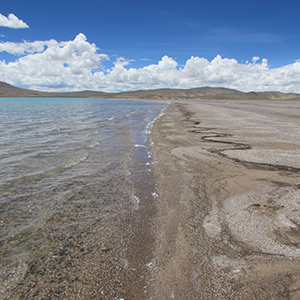Sub-fossil chironomids as indicators of hydrological changes in the shallow and high-altitude lake Shen Co, Tibetan Plateau, over the past two centuries

Accepted: 20 July 2022
Supplementary: 178
HTML: 130
All claims expressed in this article are solely those of the authors and do not necessarily represent those of their affiliated organizations, or those of the publisher, the editors and the reviewers. Any product that may be evaluated in this article or claim that may be made by its manufacturer is not guaranteed or endorsed by the publisher.
Authors
Understanding climate and monsoonal dynamics on the Tibetan Plateau is crucial, as recent hydrological changes, evidenced by rising lake levels, will be accelerated by current global warming and may alter aquatic habitats and species inventories. This study combines chironomid assemblages with sedimentological, mineralogical and geochemical data of a short sediment core (37.5 cm) from the high-altitude (> 4,733 m asl), saline (9 g L-1) and shallow (~5 m water depth) Shen Co, located in the southern part of the central Tibetan Plateau. The predominantly littoral, species-poor (10 chironomid morphotypes) chironomid assemblages are dominated by salt-tolerant taxa, that are highly sensitive to lake level fluctuations and macrophyte vegetation dynamics, making them ideally suited for tracking lake level changes over time. Results indicate a period (from ca. 1830 to 1921 CE) of drier conditions with low runoff and high evaporation rates in the Shen Co catchment, as indicated by a dominance of low-Mg calcite and dolomite and increased Ca/Fe and Sr/Rb ratios. This resulted in a decline in lake levels, an increase in salinity and the periodic occurrence of desiccation events at the sampling site. The first chironomid morphotype to appear after the dry period is Acricotopus indet. morphotype incurvatus, which indicate still low (<2 m) but rising lake levels after 1921 CE due to increasing runoff and a lower evaporation/precipitation ratio, as reflected by coarser grain size, higher quartz content and increased TN, TOC and Al/Si ratios. A replacement of A. indet. morphotype incurvatus by Procladius is observed as lake level rise continued after 1950 CE. The highest lake level is proposed for the period since 2006 CE. From 1955 to 1960 CE and from 2011 to 2018 CE, the presence of the phytophilic taxon Psectrocladius sordidellus-type supported abundant macrophyte growth. These changes are consistent with climate reconstructions from the northern and central Tibetan Plateau, indicating warmer and wetter climate conditions since the beginning of the 20th century, which have led to an increase in lake level in a number of Tibetan lakes. Our study specifically highlights 1920 and 1950 as years with enhanced precipitation. This can be attributed to the strong, with overlapping multidecadal cycles of Westerlies and monsoon systems. This study demonstrates the significance of studying small, shallow lakes, as they frequently contain aquatic communities that respond more rapidly to the changes in the lake system. In addition, this study expands our understanding of the ecology of Tibetan chironomid morphotypes, highlighting this group’s potential as paleolimnological proxies for investigating past environmental and climatic changes.
Edited by
Diego Fontaneto, CNR-IRSA Water Research Institute, Verbania, ItalySupporting Agencies
Nam Co Observation and Research Station (NAMORS), International Research Training Group, Deutsche Forschungsgemeinschaft (DFG grant 317513741 / GRK 2309), Open Access Publication Funds of the Technische Universität BraunschweigHow to Cite

This work is licensed under a Creative Commons Attribution-NonCommercial 4.0 International License.
Similar Articles
- Svein Birger WÆRVÅGEN, Jens Petter NILSSEN, Life histories and seasonal dynamics of common boreal pelagic copepods (Crustacea, Copepoda) inhabiting an oligotrophic Fennoscandian lake , Journal of Limnology: Vol. 69 No. 2 (2010)
- Wen Liu, Jilili Abuduwaili, Long Ma, Geochemistry of major and trace elements and their environmental significances in core sediments from Bosten Lake, arid northwestern China , Journal of Limnology: Vol. 78 No. 2 (2019)
- Aldo Marchetto, Simona Musazzi, A procedure to update quality indices based on species abundances: an example using the EPI-L diatom index , Journal of Limnology: Vol. 82 (2023)
- Andrea LAMI, Aldo MARCHETTO, Rossana LO BIANCO, Peter G. APPLEBY, Piero GUILIZZONI, The last ca 2000 years palaeolimnology of Lake Candia (N. Italy): inorganic geochemistry, fossil pigments and temperature time-series analyses , Journal of Limnology: Vol. 59 No. 1 (2000)
- Chris J. CURTIS, Roger FLOWER, Neil ROSE, James SHILLAND, Gavin L. SIMPSON, Simon TURNER, Handong YANG, Sergi PLA, Palaeolimnological assessment of lake acidification and environmental change in the Athabasca Oil Sands Region, Alberta , Journal of Limnology: Vol. 69 No. s1 (2010): Impacts of sulphur and nitrogen deposition in western Canada
- Daniel SPITALE, Alessia SCALFI, Horst LANGE-BERTALOT, Marco CANTONATI, Using different epilithic-diatom assemblage metrics for an ecological characterization of the shores of Lake Garda , Journal of Limnology: Vol. 70 No. 2 (2011)
- Elena LEGNANI, Diego COPETTI, Alessandro OGGIONI, Gianni TARTARI, Maria Teresa PALUMBO, Giuseppe MORABITO, Planktothrix rubescens’ seasonal dynamics and vertical distribution in Lake Pusiano (North Italy) , Journal of Limnology: Vol. 64 No. 1 (2005)
- Mauro L. Veronesi, Alberto Barbieri, Kurt W. Hanselmann, Phosphorus, carbon and nitrogen enrichment during sedimentation in a seasonally anoxic lake (Lake Lugano, Switzerland) , Journal of Limnology: Vol. 61 No. 2 (2002)
- Pierluigi Colangeli, Adam Cieplinski, Ulrike Obertegger, Filming of zooplankton: a case study of rotifer males and Daphnia magna , Journal of Limnology: Vol. 75 No. 1 (2016)
- Zhuo Zhang, Changchun Huang, Fei Guo, Zhiyao Song, Di Hu, A new technology for suspended sediment simulation in Lake Taihu, China: Combination of hydrodynamic modeling and remote sensing , Journal of Limnology: Vol. 78 No. 1 (2019)
<< < 50 51 52 53 54 55 56 57 58 59 > >>
You may also start an advanced similarity search for this article.
-
Paula Echeverría‐Galindo, Sonja Rigterink, Julieta Massaferro, Liseth Pérez, Bernd Wünnemann, Philipp Hoelzmann, Wengang Kang, Nicole Börner, Anja Schwarz, Andreas Laug, Ping Peng, Junbo Wang, Liping Zhu, Antje SchwalbJournal of Quaternary Science : 2023
-
Marco Bertoli, Gianguido Salvi, Rachele Morsanuto, Elena Pavoni, Paolo Pastorino, Giuseppe Esposito, Damià Barceló, Marino Prearo, Elisabetta PizzulDiversity : 2024

 https://doi.org/10.4081/jlimnol.2022.2077
https://doi.org/10.4081/jlimnol.2022.2077





